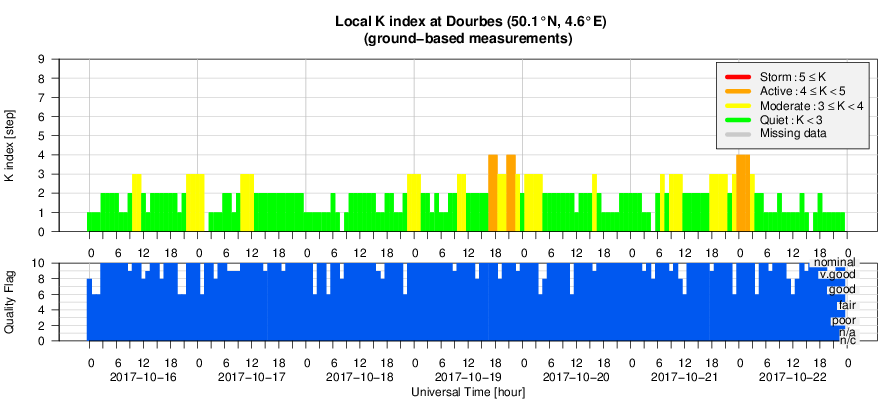- Table of Content
- 1.The best of......
- 2.Workshop about...
- 3.ESWW14 keynote...
- 4.PROBA2 Observa...
- 5.Review of sola...
- 6.Review of geom...
- 7.The SIDC Space...
- 8.Noticeable Sol...
- 9.The Internatio...
- 10.Geomagnetic Ob...
- 11.Review of iono...
- 12.Future Events
2. Workshop about polar research - Dec 4 2017
3. ESWW14 keynotes and sessions time schedule
4. PROBA2 Observations (16 Oct 2017 - 22 Oct 2017)
5. Review of solar activity
6. Review of geomagnetic activity
7. The SIDC Space weather Briefing
8. Noticeable Solar Events (16 Oct 2017 - 22 Oct 2017)
9. The International Sunspot Number
10. Geomagnetic Observations at Dourbes (16 Oct 2017 - 22 Oct 2017)
11. Review of ionospheric activity (16 Oct 2017 - 22 Oct 2017)
12. Future Events
The best of... 2016!
A compilation of the most memorable space weather moments of 2016 can be found at the STCE's dedicated Solar Cycle 24 page: http://www.stce.be/highlights
Using the fantastic (J)Helioviewer software (http://www.jhelioviewer.org/ ), a ***MOVIE*** was created containing one or more clips of each event. Usually, SDO-images were used, occasionally supplemented with imagery from PROBA2 and SOHO.
The movie can be found at https://www.youtube.com/watch?v=F355pug_RUM , whereas the page with the accompanying information is at http://www.stce.be/news/407/welcome.html
We wish you a happy viewing!
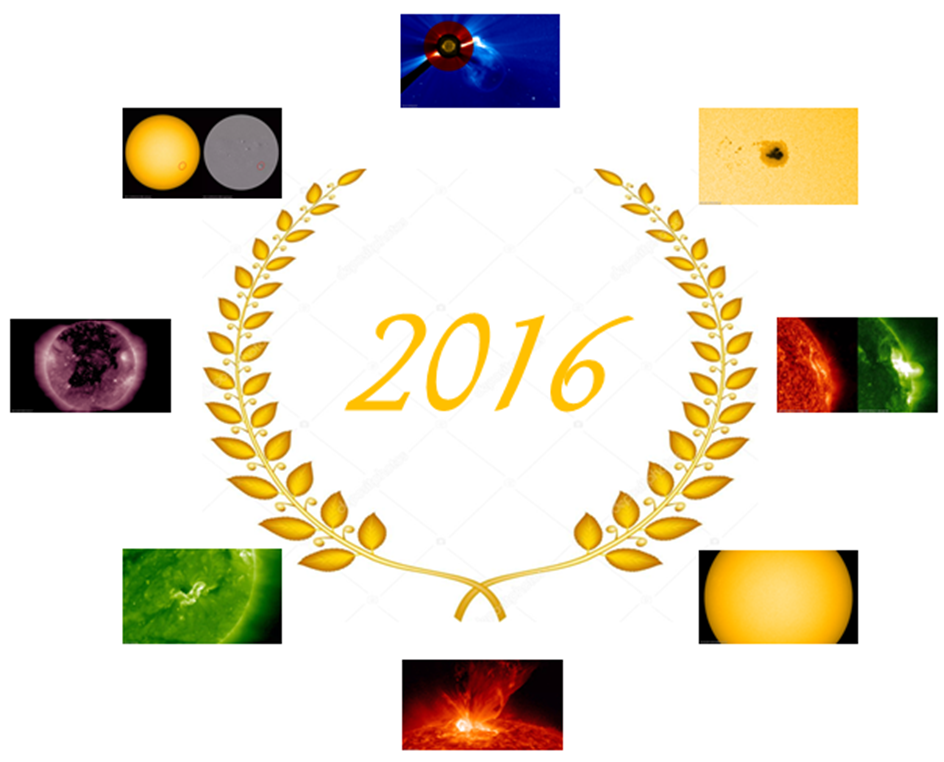
Workshop about polar research - Dec 4 2017
Link between atmospheric research and radio science about the Earth poles
The neutral and ionised atmosphere can significantly affect radio waves propagation and this can lead to misinterpretations of data and models. Earth science studies using e.g. INSAR, LOFAR and GNSS data should therefore definitely take up-to-date atmospheric parameters into account. This is the case for studies on surface deformation, cryosphere dynamics etc. in the polar regions.
To pose a solid bridge between the atmospheric and impacted scientific communities, this workshop solicits contributions to facilitate exchange of information on their respective states of the art as well as on their future needs in Polar Regions (Antarctica and Arctic).
Practical
A 1 day workshop on December 4.
Organisation by the STCE, in the buildings of the Royal Observatory of Belgium, Brussels: https://events.oma.be/indico/event/33/
Welcome!

ESWW14 keynotes and sessions time schedule
The keynotes and the time schedules of the sessions are online.
Click on a session: http://www.stce.be/esww14/program/sessions.php
The keynotes: http://www.stce.be/esww14/program/keynotes.php
Not yet online, but in the pipeline: the esww14 tutorial. And, during the fair, a demonstration of the planeterrella will be given.

PROBA2 Observations (16 Oct 2017 - 22 Oct 2017)
Solar Activity
Solar flare activity fluctuated between very low and moderate during the week.
In order to view the activity of this week in more detail, we suggest to go to the following website from which all the daily (normal and difference) movies can be accessed: http://proba2.oma.be/ssa
This page also lists the recorded flaring events.
A weekly overview movie can be found here (SWAP week 395):
http://proba2.oma.be/swap/data/mpg/movies/weekly_movies/weekly_movie_2017_10_16.mp4
Details about some of this week's events, can be found further below.
If any of the linked movies are unavailable they can be found in the P2SC movie repository here:
http://proba2.oma.be/swap/data/mpg/movies/
Friday Oct 20
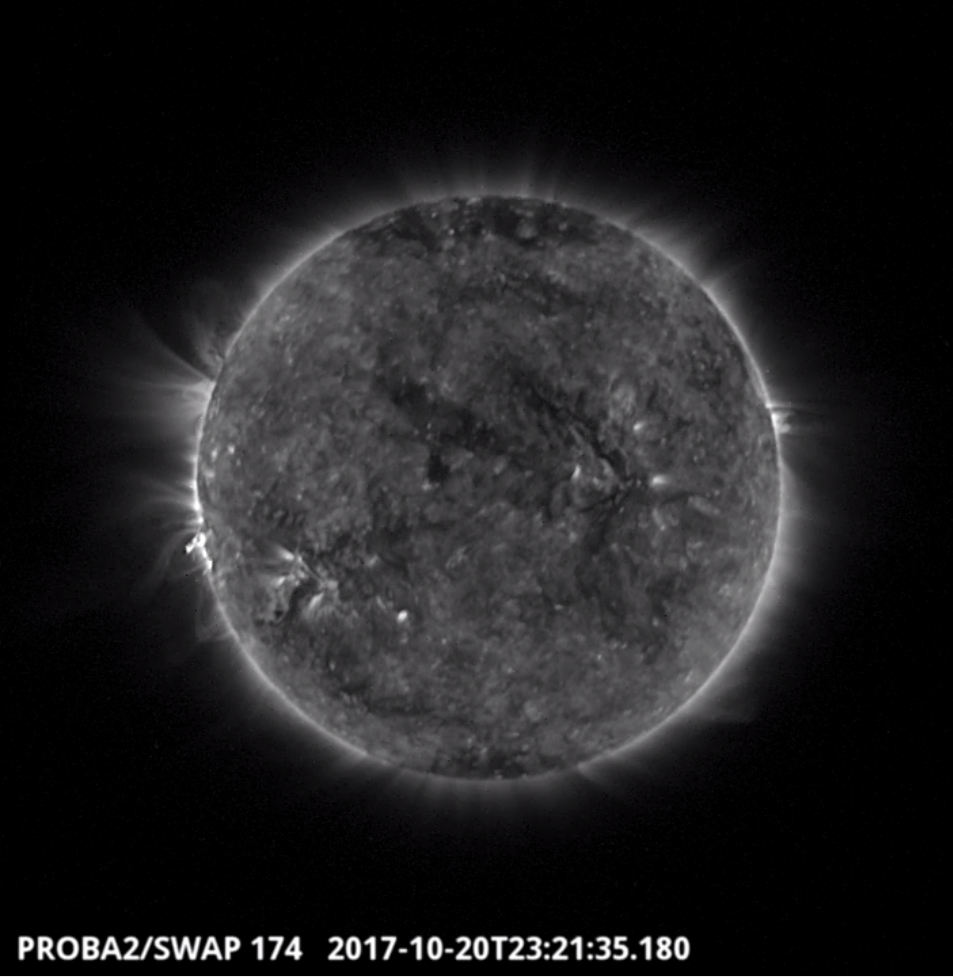
The largest flare of the week was an M-class (M1.1) flare and was observed by SWAP on 2017-Oct-20. The flare and corresponding eruption is visible on the eastern limb of the Sun in the SWAP image above at 23:21 UT.
Find a movie of the event here (SWAP movie):
http://proba2.oma.be/swap/movies/20171020_swap_movie.mp4
Review of solar activity
The GOES X-ray background was below B level throughout the week. The active regions present were NOAA 2684 (beta, then decaying) and NOAA 2685 (alpha, is returning region NOAA 2682).
From near the East limb, NOAA 2685 produced a few low B flares, and a long duration M1.1 flare peaking at 23:28 UT on October 20. An associated bright CME was first seen in LASCO C2 at 00:00 UT on October 21, from the northeast to the southeast. Due to the source location behind the East limb, this CME was not geoeffective.
The greater than 10 MeV proton flux was at nominal levels throughout the week.
Review of geomagnetic activity
On October 16 and 17, Earth was in the aftermath of a high speed stream from a positive north polar coronal hole. The solar wind speed measured by DSCOVR decreased from about 540 km/s to values around 350 km/s on October 18.
First period of enhanced solar wind speed
From the UT evening of October 18 until the UT afternoon of October 20, the solar wind speed climbed again to values around 500 km/s. This wind was probably linked with the open magnetic field of the positive north polar crown coronal hole. Positive magnetic field lines point outward from the Sun.
Second period of enhanced solar wind speed
A small, fast forward shock in the solar wind, observed by DSCOVR at 5:16 UT on October 21, introduced the next interval of enhanced solar wind activity, with solar wind speeds up to 510 km/s around 22 UT on October 21. The shock was followed by a sector boundary crossing from a sector with an outward (positive) to an inward (negative) Interplanetary Magnetic Field (IMF). This suggests the influence of the negative equatorial coronal hole which was located south of the solar equator.
The solar wind speed then decreased to around 380 km/s.
Geomagnetic respons to the Interplanetary Magnetic Field
The magnitude of the total Interplanetary Magnetic Field (IMF) reached values slightly above 10 nT during the two periods of enhanced solar wind conditions. However, Bz was never below -5 nT for a longer period. The local geomagnetic index K in Dourbes, Belgium levels did not exceed the value of 4, i.e. active conditions.
The SIDC Space weather Briefing
The Space Weather Briefing presented by the forecaster on duty from October 16 to 22. It reflects in images and graphs what is written in the Solar and Geomagnetic Activity report.

Noticeable Solar Events (16 Oct 2017 - 22 Oct 2017)
| DAY | BEGIN | MAX | END | LOC | XRAY | OP | 10CM | TYPE | Cat | NOAA |
| 20 | 2310 | 2328 | 2337 | M1.1 | II/1 | 2685 |
| LOC: approximate heliographic location | TYPE: radio burst type |
| XRAY: X-ray flare class | Cat: Catania sunspot group number |
| OP: optical flare class | NOAA: NOAA active region number |
| 10CM: peak 10 cm radio flux |
The International Sunspot Number
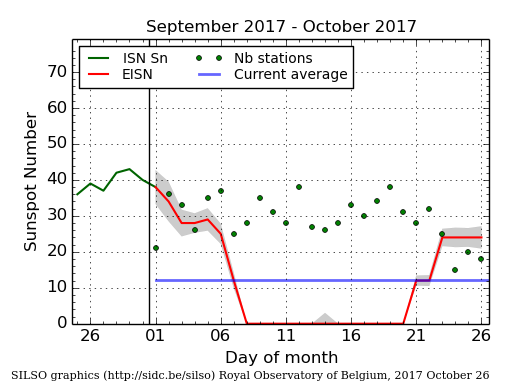
The daily Estimated International Sunspot Number (EISN, red curve with shaded error) derived by a simplified method from real-time data from the worldwide SILSO network. It extends the official Sunspot Number from the full processing of the preceding month (green line). The plot shows the last 30 days (about one solar rotation). The horizontal blue line shows the current monthly average, while the green dots give the number of stations included in the calculation of the EISN for each day.
Review of ionospheric activity (16 Oct 2017 - 22 Oct 2017)
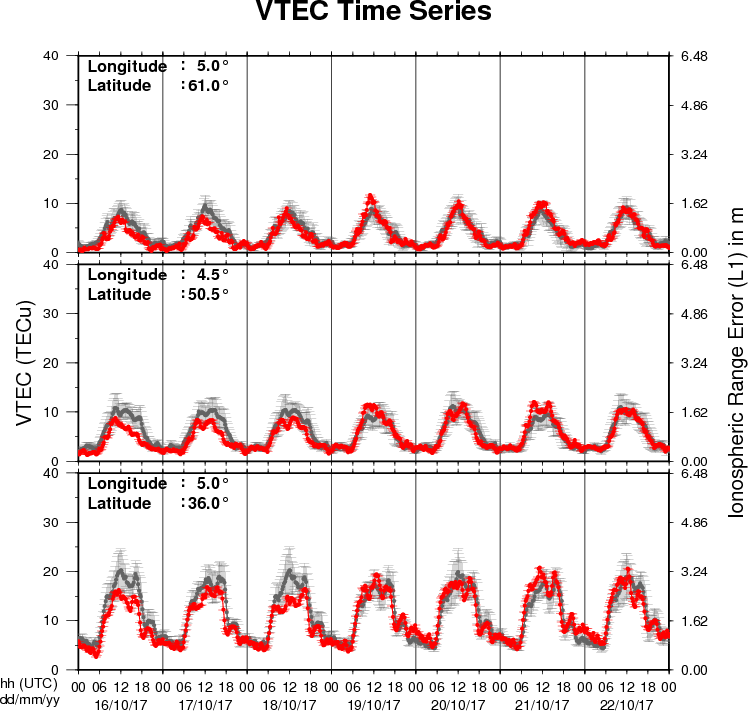
The figure shows the time evolution of the Vertical Total Electron Content (VTEC) (in red) during the last week at three locations:
a) in the northern part of Europe(N61°, 5°E)
b) above Brussels(N50.5°, 4.5°E)
c) in the southern part of Europe(N36°, 5°E)
This figure also shows (in grey) the normal ionospheric behaviour expected based on the median VTEC from the 15 previous days.
The VTEC is expressed in TECu (with TECu=10^16 electrons per square meter) and is directly related to the signal propagation delay due to the ionosphere (in figure: delay on GPS L1 frequency).
The Sun's radiation ionizes the Earth's upper atmosphere, the ionosphere, located from about 60km to 1000km above the Earth's surface.The ionization process in the ionosphere produces ions and free electrons. These electrons perturb the propagation of the GNSS (Global Navigation Satellite System) signals by inducing a so-called ionospheric delay.
See http://stce.be/newsletter/GNSS_final.pdf for some more explanations ; for detailed information, see http://gnss.be/ionosphere_tutorial.php
Future Events
For more details, see http://www.spaceweather.eu/en/event/future
International Workshop on Solar, Heliospheric & Magnetospheric Radioastronomy in Meudon, France
Start : 2017-11-06 - End : 2017-11-10
Jean-Louis Steinbeg has been one of the major pioneers in
radioastronomy. Co-founder of the Nançay Observatory, he
has actively participated to, an inspired a large number of radio
instruments on many international space missions. Jean-Louis
Steinberg is the founder of the Space Radioastronomy laboratory of
the Paris Observatory in 1963. Later on, this laboratory widened
its science interests and became the DESPA (1971) and then the
current LESIA (2002) which is one of the major space sciences
laboratories in France. The aim of this workshop is to cover the
science topics which Jean-Louis Steinberg has promoted during his
career, focusing on Solar, Heliospheric & Magnetospheric
radioastronomy & physics. This will be done by covering both
observations from either ground facilities (NDA, RH, LOFAR, Artemis
etc ...) or space missions (ISSEE, Ulysses, WIND, CLUSTER, STEREO,
CASSINI, JUNO etc ...) and models/theories. A series of invited
talks is also foreseen to cover the new developments in the
discipline which may come with the future facilities such as Solar
Orbiter, Solar Probe Plus, JUICE, JUNO, LOFAR+, SKA etc ....
This workshop will also be the opportunity to remember both the
extraordinary personal & professional lifes of Jean-Louis
Steinberg especially for new generation of scientists. At the
occasion of this workshop it is also expected that the Building 16
(historical Space Sciences building) on the Meudon campus will be
renamed "Building Jean-Louis Steinberg".
Website:
https://jlsworkshop.sciencesconf.org/
European Space Weather Week 14
Start : 2017-11-27 - End : 2017-12-01
The ESWW is the main annual event in the European Space Weather
calendar. It is the European forum for Space Weather as proven by
the high attendance to the past editions. The agenda will be
composed of plenary/parallel sessions, working meetings and
dedicated events for service end-users. The ESWW will again adopt
the central aim of bringing together the diverse groups in Europe
working on different aspects of Space Weather.
Website:
http://www.stce.be/esww14/
